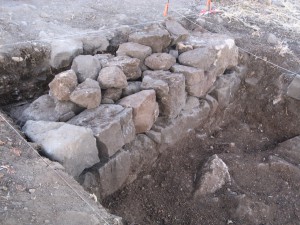My first full week of work, though certainly intense and tiring, has only increased my fascination with archaeology and ancient history. We began excavating our squares on Monday after the directors divided us into small groups; they placed me with Elvira, my fellow Eph, as well as two other students, with Professor Jason Schlude of Duquesne University as our square supervisor.
Even as the initial exhilaration of discovering a 5th-century piece of marble facing or small glass fragments slowly wears off, I have become increasingly curious about the context of our square as a whole. What bigger mosaic did these tesserae fit into, I wonder? What would the inhabitants of the town at Omrit have felt about this imported fineware pottery fragment, and how did they feel it compared to their local wares? Was this glass vessel, of which we have only a handle, handed down from generation to generation, and how did its meaning to its owner change over time?
Although the first few days of digging consisted primarily of removing “tumble”–the disturbed, loose upper layers of cobbles and soil that cover ancient features of an area–we soon found a Byzantine spoliated wall in the southern part of our square that we have continued to work on uncovering in the past few days. Shortly thereafter, we found a wall almost parallel to it in the northern part of the square. (We named them Lydia’s and Elvira’s Walls, respectively.) We have also uncovered limestone ashlars that seem to have fallen from the top of the wall, probably with human intervention. Today, we began finding more and larger fragments of things such as glass vessels and pottery, indicating that we may soon reach some kind of floor. We hope eventually to find Early Roman occupation in our square, but we are excited for the moment to have discovered this Byzantine structure, whatever it turns out to be. I look forward to further exploring the context of the square in the next few weeks as we into the digging of more delicate areas.

